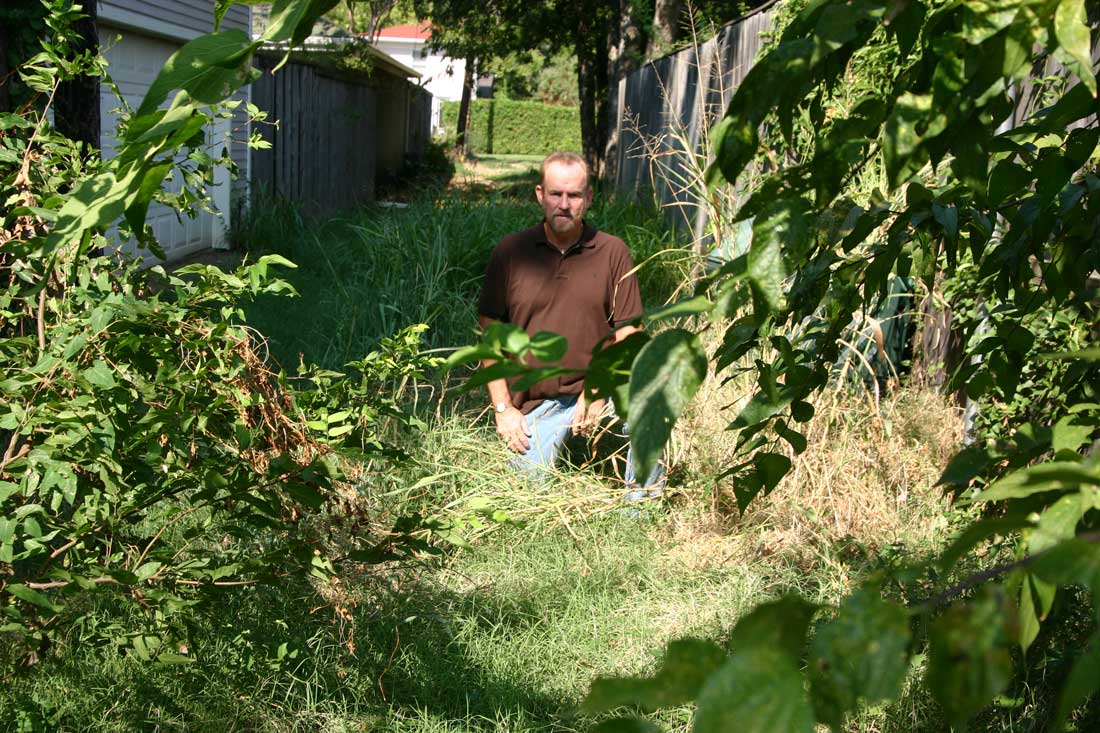A green alley runs behind houses along West Magnolia and Harrison avenues in the historic Mistletoe Heights neighborhood, providing city and utility workers access to water, electric, and gas lines. Jim Malloy has lived on Harrison Avenue since 1986, and he said the city has regularly sent crews to mow and trim the alley.
This year, however, weeds and scrub trees in the alley have run amok, some of them reaching chest-high on Malloy, who stands well over 6 feet. And the rodents have arrived.
Malloy said he’d never seen signs of rats in his house until this year, and he wonders if the overgrown alley has become their haven. He called the city and was told the budget for alley maintenance has been slashed in recent years and could take another hit in 2014.
“For my property taxes, which are going to be $5,416 this year, I’m down to getting my garbage picked up once a week and bulk pickup once a month,” Malloy said.
Fort Worth officials are currently crunching numbers for next year’s budget, and every bit that gets cut has the potential to create a problem somewhere. Fort Worth City Council members expressed concern with some of the proposed cuts, including the reduction in alley maintenance, during an Aug. 15 budget workshop.
Woody Bruner lives a block away from Malloy, backed up to the same alley, and he too has noticed rats. He wrote a letter to the Mistletoe Heights Neighborhood Association in July.
“The weeds are very dry and an obvious fire hazard,” he said. “It would only take one cigarette butt.”
Bruner has lived on Magnolia for 37 years and routinely mows and maintains the part of the alley behind his house and a couple of others. However, he doesn’t want to have to maintain the entire alley that stretches the length of about 10 houses.
Ironically, the same guy who has spent almost 40 years maintaining a portion of the city’s property for free was recently cited by code enforcement for parking an old truck in the alley.
Malloy is worried about “mower-wrecking rocks” hidden under the weeds, like the one that damaged a mower blade recently while he was cutting weeds in the alley. He asked a city official how residents could encourage the city to maintain its own property.
“They said a neighbor would have to file a complaint, and the city would come out and issue a citation,” Malloy said. “Is the city going to fine itself?”
The neighbors are also perturbed that city officials didn’t notify them about the alley maintenance being stopped.
“They probably didn’t want to let the word out,” Malloy said.
It’s particularly irksome to Malloy, who doesn’t agree with some of the other proposals floated at city hall, such as re-striping nearby Forest Park Boulevard for bicycle lanes at an estimated cost of $70,000.
During a budget discussion in August, Transportation/Public Works Director Doug Wiersig told council members that the alley mowing budget would decrease from last year’s figure of $379,000 to $189,000, in a proposed $1.48 billion budget.
Some council members weren’t happy, particularly those whose districts include poorer neighborhoods with high crime rates, areas that the city already overlooks at times. But those neighbors might be more likely to survive cuts in alley maintenance. Malloy said city officials told him the maintenance crews were going to focus their efforts on alleys in blighted areas. Malloy interpreted that as the city relying on residents in middle-class neighborhoods to mow their own.
He wrote letters to Mayor Betsy Price and council member Joel Burns saying he expected the alleyways to be maintained.
The letter of complaint that Bruner sent to his homeowners association was intended to get residents more involved in maintaining the alleyway. “I’d love for the city to do more, but I don’t want to see my taxes go up either,” he said. “The city only does what we fund. Given the choices of where to cut services in the city, I’d rather them cut [alley maintenance] than police or fire protection.”
The maintenance program seems to have as many lives as an alley cat.
The city disbanded its original alley maintenance program in 1990 and went 17 years without it, city spokesman Bill Begley said.
Bruner remembers it well. During that time, the overgrown alley caught on fire, and the flames leapt to two nearby garages, destroying one and severely damaging another.
Alley maintenance was re-established in 2007, with funding eventually increasing enough to maintain 1,500 alley blocks each year, including the one behind Bruner’s and Malloy’s houses. However, the economic downturn from last decade led to new cuts, and by 2010 the program was discontinued again. It was back in action in 2012 but lost half its funding in the last budget cycle.
“The number of alley blocks [to be maintained] went from 1,470 to 827,” Begley said.
City officials determine which alleys to maintain based on the number of complaints to police and code compliance, he said.
“It’s not just mowing, it’s also cleaning,” he said.
On Aug. 22, interim chief financial officer Jay Chapa spoke with city council members at a budget workshop and proposed keeping the alley maintenance budget for 2014 at its current level, along with reinstating money for street maintenance and athletic facility maintenance.
Council member Sal Espino expressed relief.
“We need to keep maintaining our facilities and infrastructure so that later on we don’t have to spend much more or have to completely rebuild them,” he said. “The program amendments are well thought out, and I fully support them.”
Colleague Jungus Jordan recognized the juggling act that city employees must go through when planning a budget.
“We’d all like to fund everything 100 percent but we just have to get to ‘what do we need’ and not ‘what do we want,’ ” he said.













The Forest Park bike lanes and the alleys have nothing at all to do with each other. I agree the alleys should be maintained, but Malloy just sounds like a typical anti-progress crank.
One large can of Round Up for the entire alley now. Yes, then you have to clean up the dead debris this year. October this year and January next year apply a couple of bags of seed germination preventer. More Round Up in spring. That should provide 90% relief for the years ahead. I had one of those “green spaces” in Mistletoe myself. I mis t let oe a bit myself.
Bikers have feelings too.
Bike lanes are dangerous both to the biker and the drivers of cars especially on a busy thoroughfare like Forest Park. In fact, a number of early bike lane adopting cities have since reversed their decision for safety reasons. The alleyways belong to th city and as such should be maintained regardless of bike lanes. You try letting the grass grow up on you property over six feet tall and see if you don’t get an unfriendly city visit. It’s no different if there are city owned vacant lots they don’t cut them until they become overgrown and dangerous. The city shouldn’t be investing money into private business ventures but they should take care of streets and city services. Note to City: Stop building condos. Start mowing and fixing potholes.
Bike lanes are dangerous both to the biker and the drivers of cars especially on a busy thoroughfare like Forest Park. In fact, a number of early bike lane adopting cities have since reversed their decision for safety reasons. The alleyways belong to th city and as such should be maintained regardless of bike lanes. You try letting the grass grow up on you property over six feet tall and see if you don’t get an unfriendly city visit. It’s no different if the
The city shouldn’t be investing money into private business ventures but they should take care of streets and city services. Note to City: Stop building condos. Start mowing and fixing potholes.
Bike lanes are dangerous both to the biker and the drivers of cars especially on a busy thoroughfare like Forest Park. In fact, a number of early bike lane adopting cities have since reversed their decision for safety reasons. The alleyways belong to the city and as such should be maintained regardless of bike lanes. You try letting the grass grow up on you property over six feet tall and see if you don’t get an unfriendly city visit. It’s no different if the
The city shouldn’t be investing money into private business ventures but they should take care of streets and city services. Note to City: Stop building condos. Start mowing and fixing potholes.
The city shouldn’t be investing money into private business ventures but they should take care of streets and city services. Note to City: Stop building condos. Start mowing and fixing potholes.
Holy shit Phyllis, we get it.
Pave the alleys and assess each adjoining owner their share of the cost.
seems like this would be the easiest long term solution, and I’m sure the city could subsidize the cost somewhat
Why should a property owner have to pay for an alley paving job when the city owns the alley?